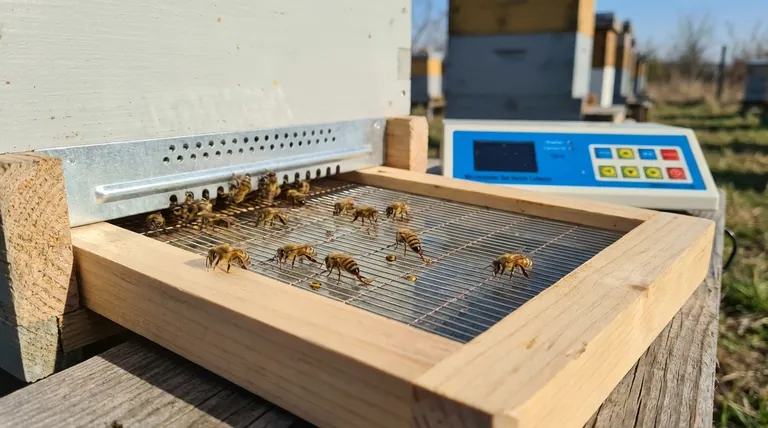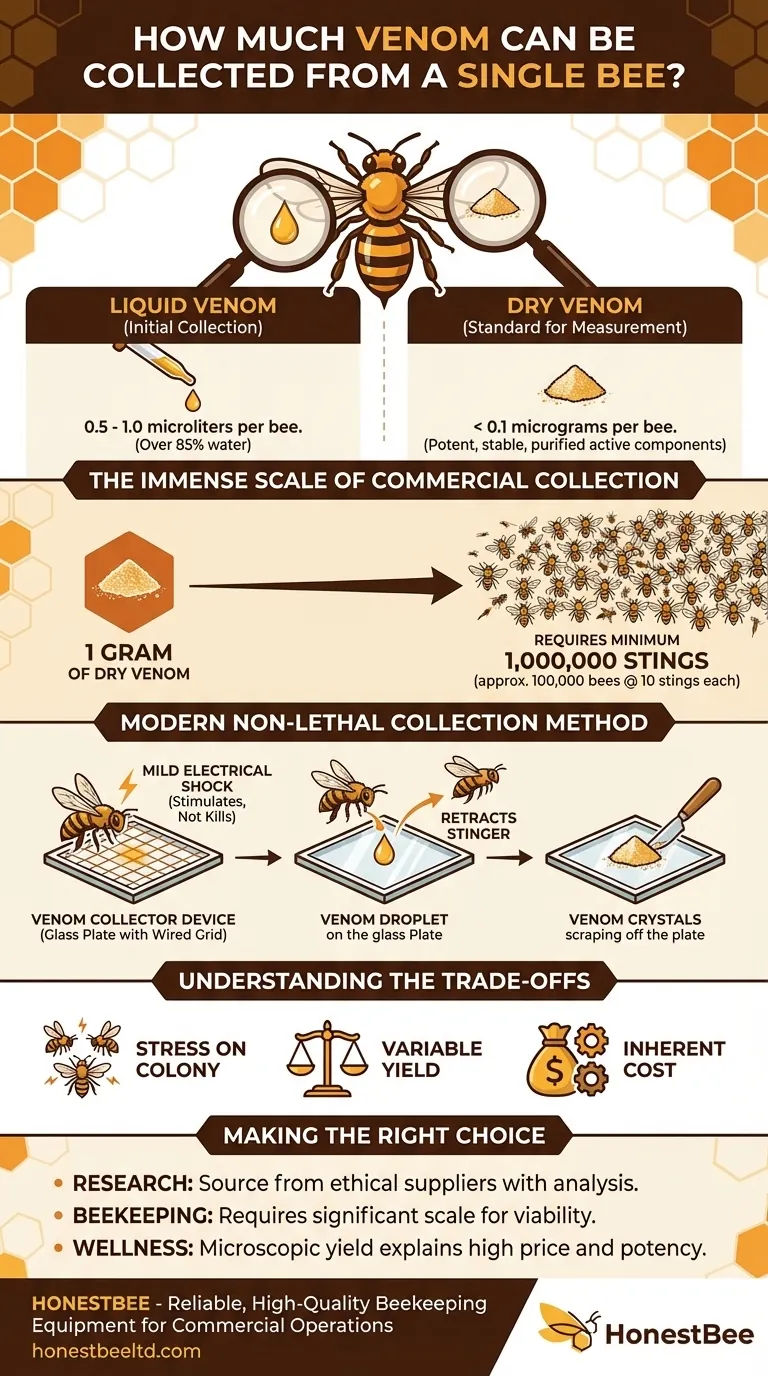A single honeybee produces an astonishingly small amount of venom. In a controlled collection setting, one bee can provide about 0.5 to 1.0 microliters of liquid venom over the course of approximately ten "stings." Once this liquid is dried to a powder for stability and use, you are left with less than 0.1 micrograms of actual venom crystals per bee.
To truly grasp the scale, consider this: collecting just one gram (a fraction of a teaspoon) of dry bee venom requires a minimum of one million stings. This microscopic yield is the primary reason for its high value and the specialized methods required for its collection.

Deconstructing the Numbers: Volume vs. Dry Weight
The two different measurements for bee venom—liquid volume and dry weight—can be confusing. They represent two different stages of the collection process and serve different purposes.
Liquid Venom: The Initial Collection
When a bee deposits venom, it is in a liquid form. This initial collection typically yields between 0.5 and 1.0 microliters per bee.
However, this liquid is composed of more than 85% water. The water serves as a delivery vehicle for the active compounds but has no therapeutic or commercial value itself.
Dry Venom: The Standard for Measurement
For commercial and research purposes, the water is evaporated, leaving behind the potent, active components as a crystalline powder. This is the dry venom.
A single bee contributes less than 0.1 micrograms (a ten-millionth of a gram) of this dry venom. This standardized dry form is more stable and allows for precise dosing in products and studies.
The Immense Scale of Commercial Collection
The minuscule amount of venom from one bee means that any practical application requires an operation of immense scale. The numbers illustrate the challenge clearly.
The Million-Sting Threshold
As a benchmark, producing one single gram of dry venom requires at least 1,000,000 stings.
From Individual Bees to Hives
Modern collection methods allow a single bee to "sting" a collector plate multiple times without dying. If we assume an average of ten stings per bee, gathering one gram of venom still requires the participation of 100,000 individual bees.
This is why venom collection is only feasible with multiple, thriving, and densely populated hives.
How Modern Collection Avoids Harming Bees
You might wonder how it's possible to get venom without the bee dying. Unlike stinging a mammal, modern collection doesn't involve the bee losing its stinger.
The Venom Collector Device
Beekeepers place a special device at the entrance of the hive, which consists of a glass plate with a grid of wires stretched across it. A very mild electrical current is passed through these wires.
Stimulating, Not Killing
When a bee lands on the grid, it receives a mild shock. This agitation triggers a defensive response, and the bee deposits a small droplet of venom onto the glass plate.
Because the stinger does not get snagged in skin, the bee can retract it and fly away unharmed. The process does not kill the bees.
Harvesting the Crystals
The venom droplets dry directly on the glass. The beekeeper later scrapes the resulting venom crystals off the plate, yielding the final, purified product.
Understanding the Trade-offs
While modern collection is designed to be non-lethal, it is not without impact. It's important to understand the full context.
Stress on the Colony
The collection process is stressful for the hive. When bees sting, they release alarm pheromones that can cause agitation and defensive behavior throughout the colony long after the device is removed.
Yield is Highly Variable
The quantity and quality of venom are not constant. Yield is affected by the bees' age, their diet, the season, and the overall health of the colony.
The Inherent Cost
The combination of specialized equipment, the need for a massive number of healthy bees, and the meticulous labor involved explains why pure, dry bee venom is one of the most expensive products from the hive.
Making the Right Choice for Your Goal
Understanding the scale of venom collection provides critical context for anyone involved with bee products.
- If your primary focus is research or product formulation: You must source venom from reputable suppliers who use ethical, non-lethal collection methods and can provide analysis certifying its purity and potency.
- If your primary focus is beekeeping: Recognize that venom collection is a specialized, equipment-intensive practice that requires significant scale (many hives) to be commercially viable.
- If your primary focus is personal wellness: The microscopic yield per bee explains the high price of apitherapy products and underscores the incredible potency of the active compounds.
Ultimately, the tiny drop of venom from a single bee is a powerful reminder of nature's concentration and the ingenuity required to harness it.
Summary Table:
| Measurement Type | Yield per Bee | Key Facts |
|---|---|---|
| Liquid Venom | 0.5 - 1.0 microliters | Over 85% water; initial collection form. |
| Dry Venom (Powder) | < 0.1 micrograms | Potent, stable form used commercially. |
| For 1 Gram | Requires ~1,000,000 stings | Highlights the immense scale needed for collection. |
Need reliable, high-quality beekeeping equipment for your commercial or wholesale operations?
As a commercial beekeeper or distributor, you understand that maximizing hive health and productivity is paramount. HONESTBEE supplies the durable, efficient beekeeping supplies and equipment you need to run a successful, large-scale operation. From hive management tools to protective gear, our wholesale-focused solutions are designed to support your business's growth and sustainability.
Contact HONESTBEE today to discuss your equipment needs and discover how we can help your apiary thrive.
Visual Guide

Related Products
- Full Set Beekeeping Electronic Bee Venom Collector Machine Device for Bee Venom Collecting
- HONESTBEE 6 Frame Three Use Electric Honey Extractor for Beekeeping
- 8-Frame Electric Self-Reversing Honey Extractor Spinner for Commercial Honey Extraction Equipment
- HONESTBEE Classic Pry Bar Hive Tool with High Visibility Finish for Beekeeping
- HONESTBEE 3-Frame Manual Acrylic Honey Extractor
People Also Ask
- Where is the venom collection apparatus placed in a bee colony? Optimize Yield at the Hive Entrance
- How many hives are needed on average to collect 1 gram of bee venom? A Guide to Low-Yield Harvesting
- How frequently should pollen be collected for human consumption? Optimize Your Harvesting Schedule
- How frequently should pollen be harvested from the traps? Ensure Optimal Hive Health & Superior Quality
- How long is each colony of bees 'milked' for venom collection? The 5-Minute Rule for Sustainable Harvesting



















